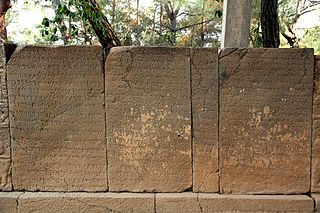 W
WThe Aztec sun stone is a late post-classic Mexica sculpture housed in the National Anthropology Museum in Mexico City, and is perhaps the most famous work of Mexica sculpture. It measures 358 centimetres (141 in) in diameter and 98 centimetres (39 in) thick, and weighs 24,590 kg (54,210 lb). Shortly after the Spanish conquest, the monolithic sculpture was buried in the Zócalo, the main square of Mexico City. It was rediscovered on 17 December 1790 during repairs on the Mexico City Cathedral. Following its rediscovery, the sun stone was mounted on an exterior wall of the cathedral, where it remained until 1885. Early scholars initially thought that the stone was carved in the 1470s, though modern research suggests that it was carved some time between 1502 and 1521.
 W
WThe cornerstone is the first stone set in the construction of a masonry foundation. All other stones will be set in reference to this stone, thus determining the position of the entire structure.
 W
WA gemstone is a piece of mineral crystal which, is cut and polished form, is used to make jewelry or other adornments. However, certain rocks and occasionally organic materials that are not minerals are also used for jewelry and are therefore often considered to be gemstones as well. Most gemstones are hard, but some soft minerals are used in jewelry because of their luster or other physical properties that have aesthetic value. Rarity is another characteristic that lends value to a gemstone.
 W
WA hand axe is a prehistoric stone tool with two faces that is the longest-used tool in human history. It is usually made from flint or chert. It is characteristic of the lower Acheulean and middle Palaeolithic (Mousterian) periods. Its technical name (biface) comes from the fact that the archetypical model is a generally bifacial and almond-shaped (amygdaloidal) lithic flake. Hand axes tend to be symmetrical along their longitudinal axis and formed by pressure or percussion. The most common hand axes have a pointed end and rounded base, which gives them their characteristic shape, and both faces have been knapped to remove the natural cortex, at least partially. Hand axes are a type of the somewhat wider biface group of two-faced tools or weapons.
 W
WThe Kafkania pebble is a small rounded river pebble about 5 centimetres (2.0 in) long, with Linear B symbols and a double axe symbol inscribed on it. It was found in Kafkania, some 7 km (4.3 mi) north of Olympia, on 1 April 1994 in a 17th-century BC archaeological context. If it were genuine, it would be the earliest writing on the Greek mainland, and by far the earliest document in Linear B. However, it is in all probability a modern forgery and a hoax.
 W
WThe Karatepe bilingual, also known as the Azatiwada inscription, is a bilingual inscription on stone slabs consisting of Phoenician and Luwian text each, which enabled the decryption of the Anatolian hieroglyphs. The artifacts were discovered at Karatepe, southern Turkey by the archaeologists Helmuth Theodor Bossert (1889–1961) and Halet Çambel (1916–2014) in 1946.
 W
WA mano is a ground stone tool used with a metate to process or grind food by hand. It is also known by the Nahuatl term metlapil.
 W
WMillstones or mill stones are stones used in gristmills, for grinding wheat or other grains. They are sometimes referred to as grindstones or grinding stones.
 W
WA standing bell or resting bell is an inverted bell, supported from below with the rim uppermost. Such bells are normally bowl-shaped, and exist in a wide range of sizes, from a few centimetres to a metre in diameter. They are often played by striking, but some—known as singing bowls—may also be played by rotating a mallet around the outside rim to produce a sustained musical note.
 W
WQuern-stones are stone tools for hand-grinding a wide variety of materials. They are used in pairs. The lower stationary stone of early examples is called a saddle quern, while the upper mobile stone is called a muller, rubber or handstone. The upper stone was moved in a back-and-forth motion across the saddle quern. Later querns are known as rotary querns. The central hole of a rotary quern is called the eye, and a dish in the upper surface is known as the hopper. A handle slot contained a handle which enabled the rotary quern to be rotated. They were first used in the Neolithic era to grind cereals into flour.
 W
WThe Rock is a boulder on the campus of Michigan State University. Once popular as a trysting site, today it serves as a billboard for campus groups and events.
 W
WA stone tool is, in the most general sense, any tool made either partially or entirely out of stone. Although stone tool-dependent societies and cultures still exist today, most stone tools are associated with prehistoric cultures that have become extinct. Archaeologists often study such prehistoric societies, and refer to the study of stone tools as lithic analysis. Ethnoarchaeology has been a valuable research field in order to further the understanding and cultural implications of stone tool use and manufacture.